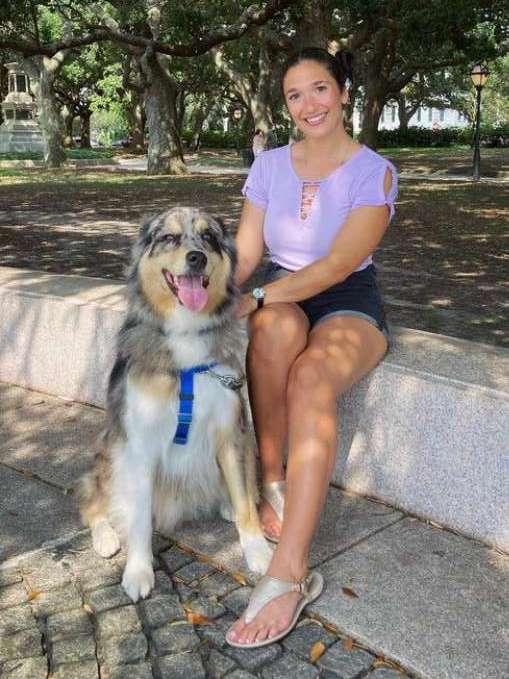Working with Therapy Dogs: Interview with Shannon Fitzgerald, LMSW
By admin / June 11, 2024 / No Comments / Uncategorized
It’s no secret that dogs make people happy. Their wagging tails, wiggling butts and gentle comfort shine light through even the darkest days. They are our perfect companions, both at home and even in the workforce, with over 50,000 dogs registered as working therapy animals in the United States today.
We talked with Shannon Fitzgerald, a veterinary social worker, about how she harnesses the power of dogs’ unlimited happiness to change people’s lives for the better. She works at the Medical University of South Carolina (MUSC), holding sessions together with her canine coworkers to help patients struggling with mental health.
Can you give a brief summary of your career?
I help humans with mental health needs regarding human and animal relationships. For example, in animal assisted therapy, the therapy dog has a relationship with the patient. And I, as the social worker, help facilitate that relationship in a way that’s going to meet their mental health needs as a human patient.
Introduce us to the therapy dogs you work with!
MUSC has like 90 or so therapy dog handler teams that they use across the hospital. I have a couple dogs that are on rotation, which is great because the patients that work with these dogs get to see them all the time and they build a relationship with them.
I have a Bernese Mountain dog named Marcel, I have a golden retriever named Bailey, and I have a Havanese named Cookie.
What does it take to be a therapy dog?
The dogs are all certified therapy dogs through various entities such as Pet Partners, Alliance for Therapy Dogs, or Therapy Dogs International. Once they’re certified therapy dogs, MUSC credentials them.
The dogs and handlers go through confidentiality training because they’re going to work in a hospital setting. They talk about limitations for the dogs because we really prioritize the dog’s wellbeing. For example, dogs cannot work longer than a two hour shift and other restrictions we have to abide by.
What we look for in our therapy dogs and therapy dogs in general is the basic obedience and training. But, also they have to have an affinity for people and interacting with people. So, when they walk in a room filled with people, they have to say: “oh my gosh! you were all here for me! I love you so much, this is great. I can’t wait for you all to pet me!” They really need that personality.
I look for therapy dogs that are gonna be calm and can handle high emotional energy in a room. We’ll talk about things like grief or depression and not all dogs are able to stay confident and collected.
When I have a woman falling on the ground crying, I need a therapy dog that’s going to recognize that, go up to her and not run away.
How do you incorporate dogs into your work?
I do what is called animal assisted therapy. I actively use the dogs as part of my therapeutic treatment within outpatient services, like psychotherapy services. I use the dogs for various things such as: teaching coping skills or communication skills and role playing. So it’s not just to teach about the skills, but to actively practice therapy skills with the dog.
We will learn how to manage anxiety using the dog as role modeling. We will do things like practice communication skills, relationship skills, boundary setting, or conflict management with the dog. They get to practice difficult therapy skills with a therapy dog. This makes it a lot easier for some patients to practice these skills.
Can you share an example of how animal assisted therapy benefits your patients?
People really connect with the dog. They actually get such great therapeutic insights that they would not have gotten outside of the animal assisted therapy. There’s something about the dog. Patients have said this to me that there is something about the dogs that makes them think differently about scenarios. They make them come to deeper understandings that bring out these really big emotional responses that need to come out and be processed. Without the dog they would not have been able to do that.
I only have the dogs there like one day a week, and patients who are struggling all week to make appointments make sure to get there on dog days. They tell me: “The only reason I came here is because the dog is here today.”
I can be an amazing therapist, but having the dog there just helps in these immense ways that I alone would not be able to.
What about your dog? Tell us about him!
I adopted Strider as an 8 week puppy. Strider is very well trained, and extremely cuddly and sweet to his mommy and all his friends/family, but he will not trust you initially and requires quite a bit of work to get comfortable with a stranger.

Therapy dogs absolutely love meeting new people, having that quality is #1 requirement to be a therapy dog. Strider gets extremely anxious meeting new people, so he is instead just a loving mama’s boy and not a therapy dog. For me, respecting my dog’s interests and boundaries is an important part of being a responsible owner.
Read More https://post.bark.co/fun/working-with-therapy-dogs/

